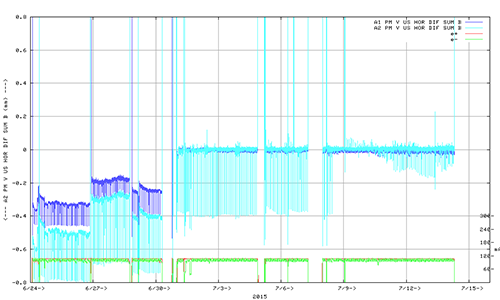X-RAY RUNS: Apply for Beamtime
2017 Nov 1 - Dec 21
2018 Feb 7 - Apr 3
2018 Proposal/BTR deadline: 12/1/17
2018 Apr 11 - Jun 4
2018 Proposal/BTR deadline: 2/1/18
Over the past few years CHESS has implemented and continually improved a vertical beam position correction program to reduce beam motion throughout each run as the beam decays as well as from run to run (see related article). One piece missing though was horizontal position stabilization. With the installation of undulators for A and G line, new beam position monitors were installed on A line which give horizontal information as well as vertical (see related article). This has allowed us to implement horizontal position corrections for the undulator beams serving A1 and A2.
A simple modification of the existing G line scatter based VBPM now gives us horizontal information there as well. In the past, most stations were relatively insensitive to horizontal beam motion due to the large size of the x-ray beam fan from the hard bend magnets and wigglers. With the smaller undulator beams we have witnessed hundred micron or larger horizontal shifts in the beam, especially after an interruption to running as seen in Figure 1. X-ray optics and user experiments can be very sensitive to these motions.

Figure 1: Horizontal beam stability measured by A-line x-ray beam position monitors before and after turning on the modified correction program. The vertical axis gives x-ray beam offsets from a zero target value with 0.2 mm per division. The horizontal axis shows days spanning June 24th to July 16th, 2015. The short vertical spike displacements from zero are due to short electron injection periods; these do not impact x-ray data collection at the user endstations.
The CESR operations crew of Laurel Bartnik and Michael Forster were able to incorporate the horizontal x-ray position signals into their vertical beam corrections program, turning that into a global beam position program. This work involved creating specialized horizontal orbit steerings and bumps near the undulator source region of the storage ring. We now successfully run this modified global corrections program every four minutes and it has reduced horizontal motion to tens of microns. In addition, we no longer see larger offsets and shifts that used to accompany planned or unplanned interruptions to storage ring operations.
Submitted by:
Chris Conolly, CHESS, Cornell University
11/13/2015
